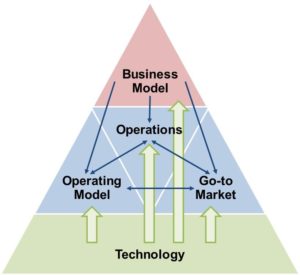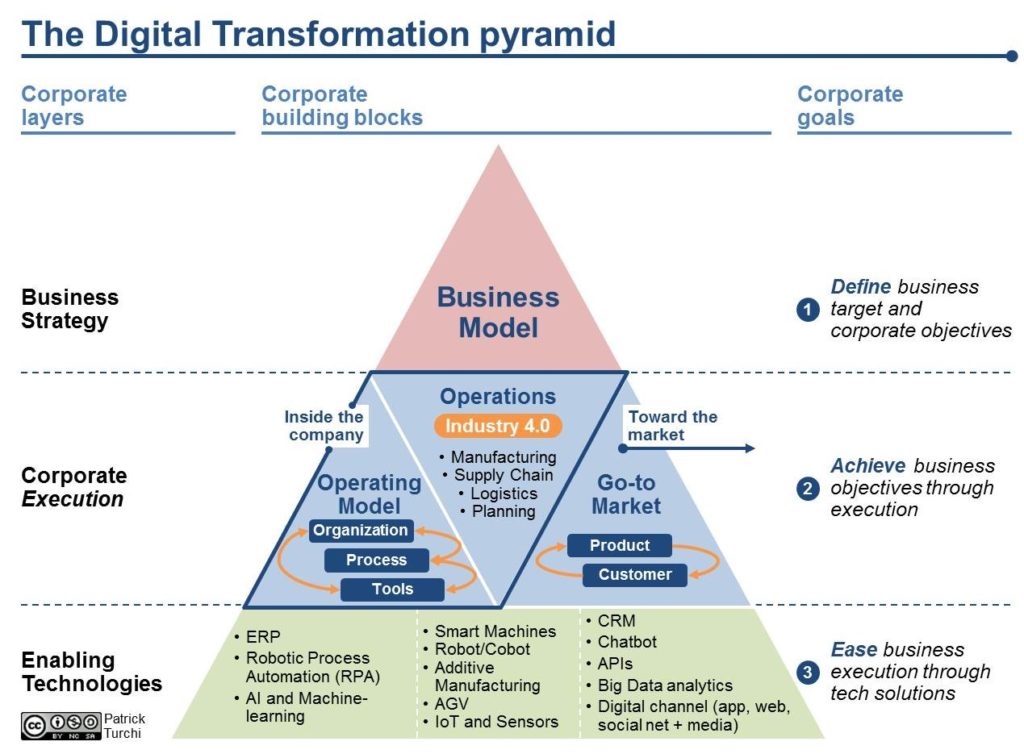Digital Transformation is currently one of the hottest business topics (and probably “the hottest”) in the corporate agenda. Truth be told, the crucial elements of Digital Transformation are still to be clearly outlined, and the areas of intervention in the corporate environment are therefore yet to be defined. Digital Transformation is not about technology.
In a recent article, Alessandro Braga (CIO of Talent Garden, the largest European co-working network, and scientific coordinator of the Digital Transformation Master of TAG Innovation School, the training unit of Talent Garden) defined six pillars (that he calls ‘axes‘) of Digital Transformation: 3 inside the company (people, process and technology) and 3 on the outside (customer, relationship and product/services).
In an article published in the MIT Sloan Review, Peter Weill (Chairman of the Center for Information Systems Research at MIT Sloan School) and Stephanie L. Woerner (Research Scientist at Center for Information Systems Research at MIT Sloan School) identified two business dimensions to assess the digital readiness of corporations: customer experience and operational efficiency.
Overall, there is a clear consensus that Digital Transformation is not about technology, but is actually about a new way of doing business, and a new way of approaching corporate models. As George Westerman states:
“When it comes to digital transformation, digital is not the answer. Transformation is”
The ‘Digital Transformation Pyramid’ Framework
Leveraging my on-field experience (I have been a Management Consultant for over 8 years, with extensive exposure to the corporate areas of strategy, organization, management control systems and corporate transformation) and on material I had access to during the past few years, I have elaborated a framework: the “Digital Transformation Pyramid“. I hope this will facilitate the definition of Digital Transformation initiatives and help understanding the impact of digital technology for corporate businesses.
In my view, there are 3 levels on which Digital Transformation needs to be approached within corporates:
- Strategy
- Execution
- Technology
An effective Digital Transformation program has to embrace at least two of the three levels – and, ideally, it must cover (in the long term) each of the 3 levels.
For example, the definition of a new ‘Digital’ Business Model, without its execution through a new Go-to Market approach, is a pure theoretical exercise that will (maybe?) remain at board-level presentation and will not change the way a business performs. On the other hand, the implementation of a new IT system (such as an ERP or CRM) or the set-up of a standalone e-commerce is not a Digital Transformation initiative, if this is not part of an overall Operating Model transformation or of a new Go-to Market approach.
It is important to acknowledge that each of the 3 level of the pyramid has a strong influence on (and actually defines) the other elements of the framework.
A successful Digital Transformation program, in fact, requires a “system” approach to embrace a truly transformational initiative. Strategy, execution or technology alone cannot transform a company: only an integrated review of (at least) two of the elements enables corporate transformation.
The Building Blocks of the Digital Transformation Pyramid
There are 5 building blocks that define the framework:
- Business Model / Business Strategy
- Operating Model
- Operations
- Go-to Market
- Technology
Each of the elements is relevant and the relationship among the elements must be taken into consideration in Digital Transformation initiatives. In fact, a new way of ‘doing business’ (both inside the company and in relation to the market) is the way a Digital Transformation program properly works.
As a matter of fact, technologies impact the Operating Model and the Operations of a company, as well as supporting the evolution of the Go-to Market (for example through a new channel approach or through the review of the product portfolio or product features). Similarly, Business Model implementation requires the definition (and evolution) of specific Operating Models, Operations activity and Market approach.

Layer 1: Strategy (Business Model)
As a Strategy Consultant, I cannot emphasise enough the importance of Strategy in Digital Transformation processes. (And, by the way, there is no such thing as Digital Strategy: only Business Strategy in a digital-enriched environment.)
When defining the Business Strategy in a digital (or digitally-enabled) environment, corporates have to evaluate opportunities and impacts (as well as potential threats) of technology-enabled Business Models (or Digital Business Models), such as (but not limited to):
- Platform business and marketplace
- Ownership model evolution (with the shift from ownership to access, through pay-per-use models)
- Value-added services through digital technology
- Data-based products (and services)
Layer 2: Execution
It is not clear weather Sir Winston Churchill actually said “However beautiful the strategy, you should occasionally look at the results”, but the point here is clear: execution is the key for corporate transformation, and Digital Transformation programs do not work differently.
Execution works in fact in two directions: inside the company and outside the company (toward the market, or the markets the company is willing to serve).
There are 3 building blocks of execution:
- Corporate Operating Model
- Operating Model of Operations
- Go-to Market approach
Each of the blocks requires a specific deep-dive, since each of the 3 building blocks is actually made of further elements, and every one of them requires special attention when developing a Digital Transformation initiative.
Nonetheless, it is important to keep in mind that, at this level, the strategy defined is realized through the very founding elements of a corporate:
- Product and Customer: which defines the offer of the business (taking into consideration key elements, such as selling price, distribution channel, promotion and communication approach, digital-enabled product value proposition, etc.)
- Organization, Procedure and Tools, which – through the Operative Model – outline the structure of the corporate and the way it works
- Operations, constitute the way the corporate realizes products (and services) that is willing to push into the market.
Those elements are, of course, the standard components of the strategy execution and are not only relevant in a Digital Transformation context. Nonetheless, it is important to highlight that in this context they require a specific approach through the evaluation of the digital and technological impact. For example, what is the “product” in a digitally-enabled context such as car-sharing platforms? Is it the service provided, the arrival at the final destination, the access to the car, the time needed, etc? And consider that the very definition of “product” has then an impact on the definition of the price, the value provided, the core product offer, etc.
Layer 3: Technology
As mentioned at the beginning, Technology is not the core of Digital Transformation, but is actually its enabler. Technology serves (and supports) the realization of the business target and objective through the ‘execution’ blocks. Technology is the enabler of the evolution of the Operating Model, of Operations (with Industry 4.0 approach) and the realization of the Go-to Market approach.
On the other hand, Technology is the driver of changes on each level of the pyramid, and being able to identify the impact of technology on each level of the pyramid is a key strategic corporate capability. It is important to identify business changes in the market driven by technology and to define strategic responses (or possibly anticipate with the correct strategic move).
The Digital Transformation Journey is about people
“Digital Transformation is a journey, not a destination“: as every other strategic activity in the corporate field, Digital Transformation initiatives need to be constantly reviewed and assessed. The acceptance of new technologies, new procedures and new organizational shapes by the corporate is a key area that requires ongoing monitoring and (if need be) quick adjustment. And, of course, as in any other corporate transformation program, Change Management is essential for the achievement of the initiative. Digital Transformation is really about people, much more than technology. For this reason, a genuine openness (and interest) towards technology and innovation is crucial within the organization (and especially in top-management) for the success of the transformation initiative. The Technology functions own the technological knowledge and know-how, but a sound understanding of the implications (and the benefits) of technology around each company function is the key to ensure the success of the Digital Transformation initiative.
P.S. The idea of the Digital Transformation framework, as well as many topics discussed in this article, was born from a long road trip Alessandro and I took a few weeks ago. Alessandro, thank you again for your great insights on this (and many other topics) and your continuous support.
Article by channel:
Everything you need to know about Digital Transformation
The best articles, news and events direct to your inbox
Read more articles tagged: Definition, Featured










